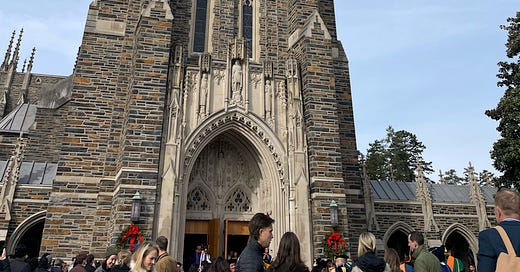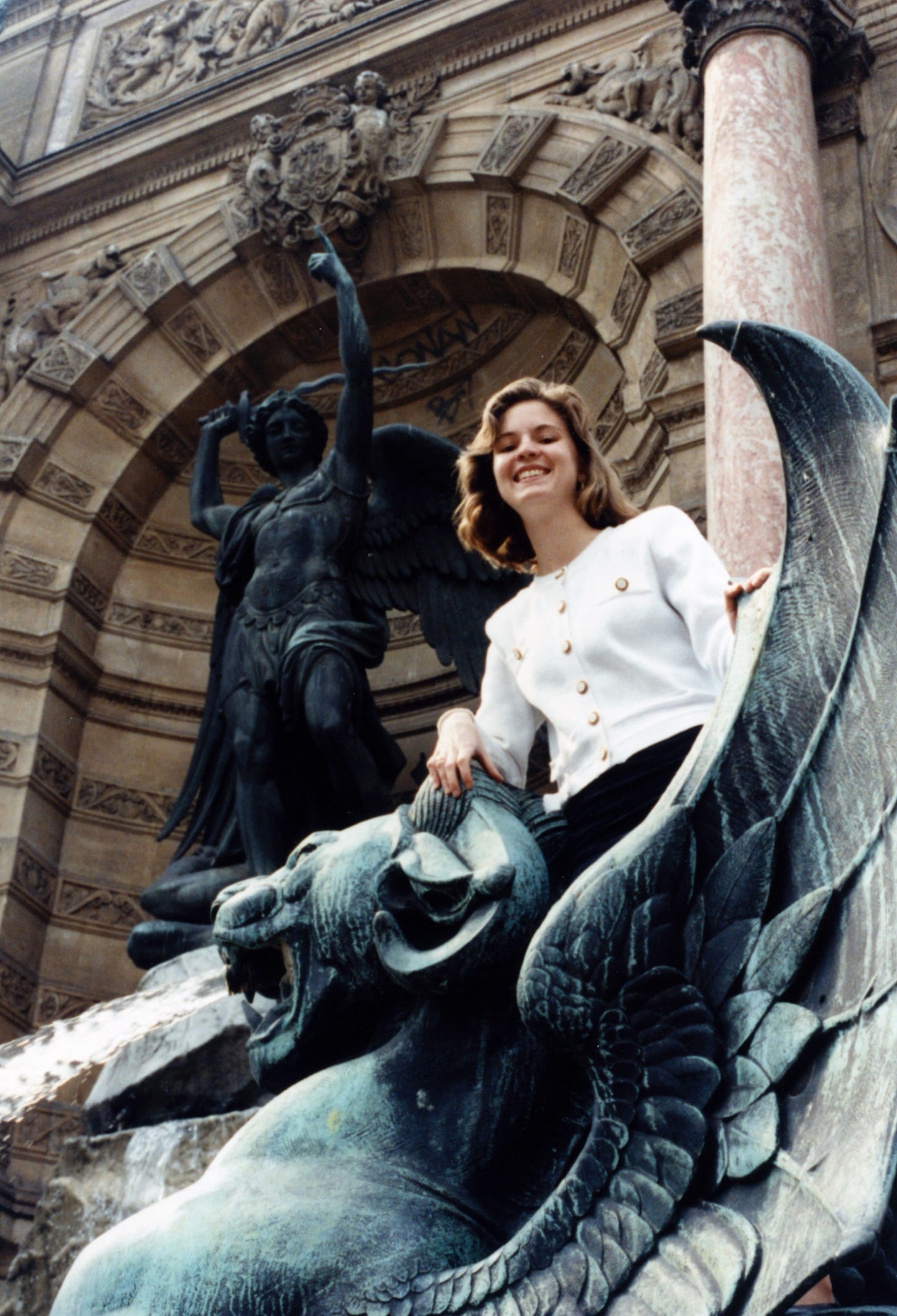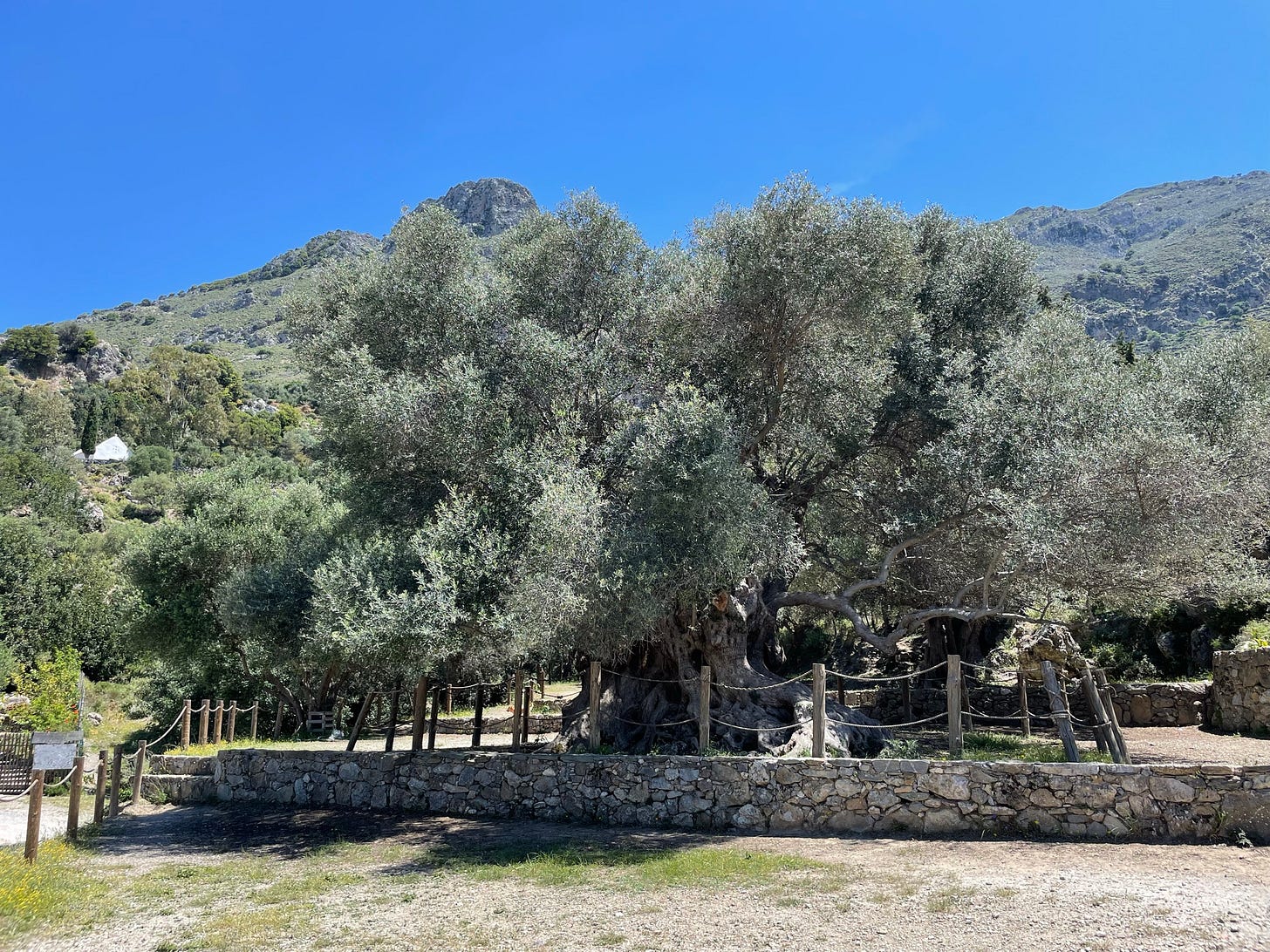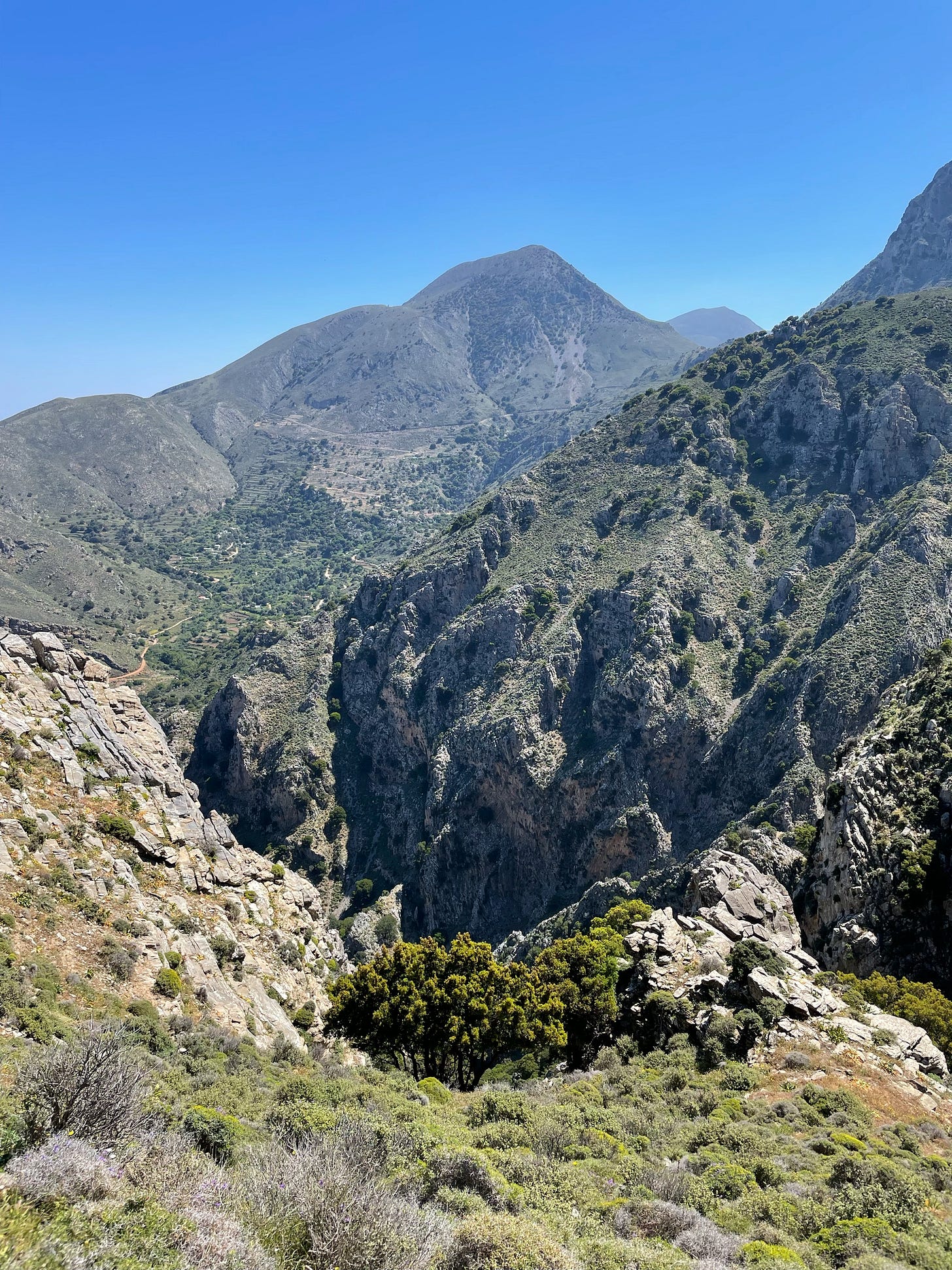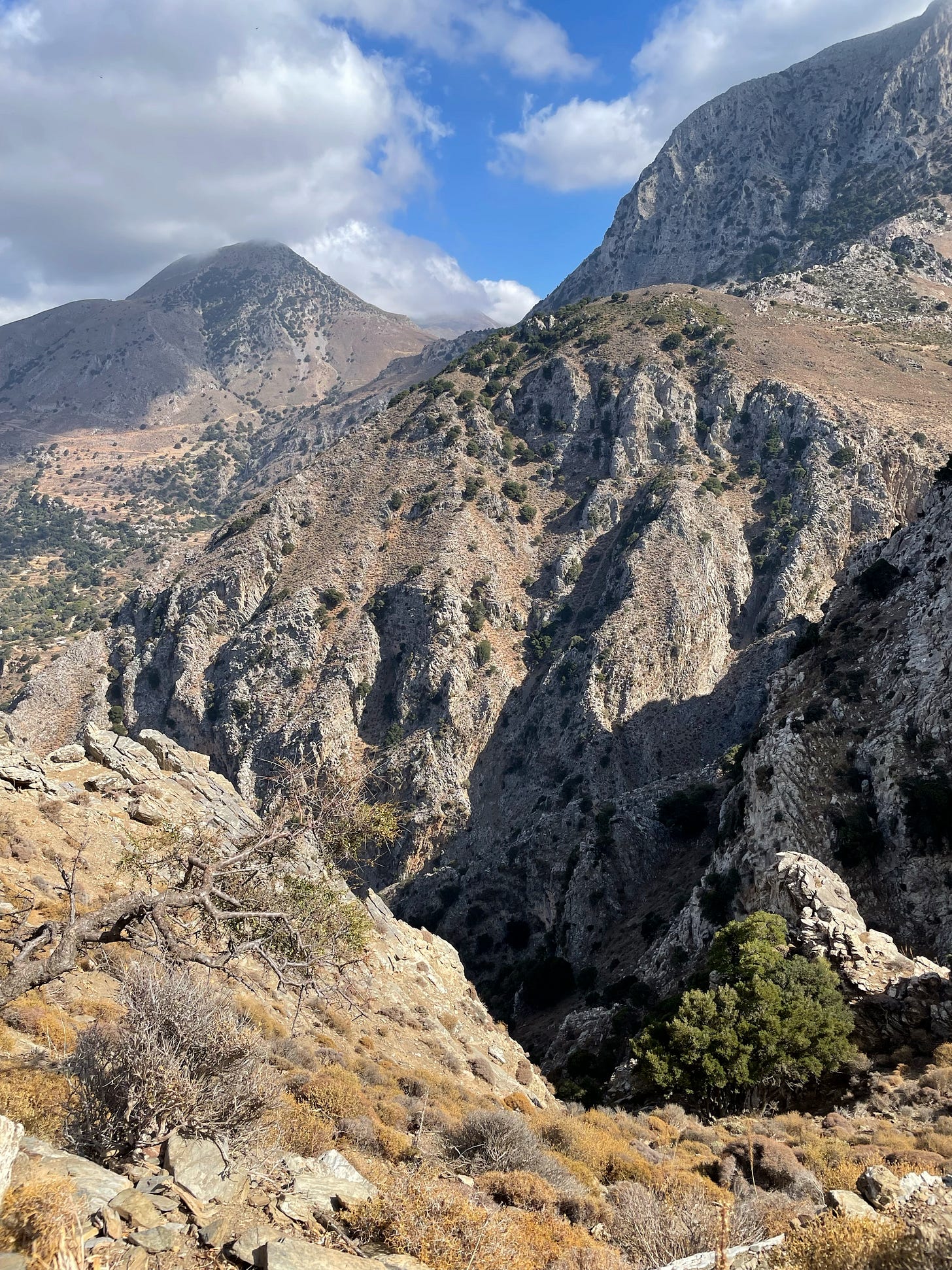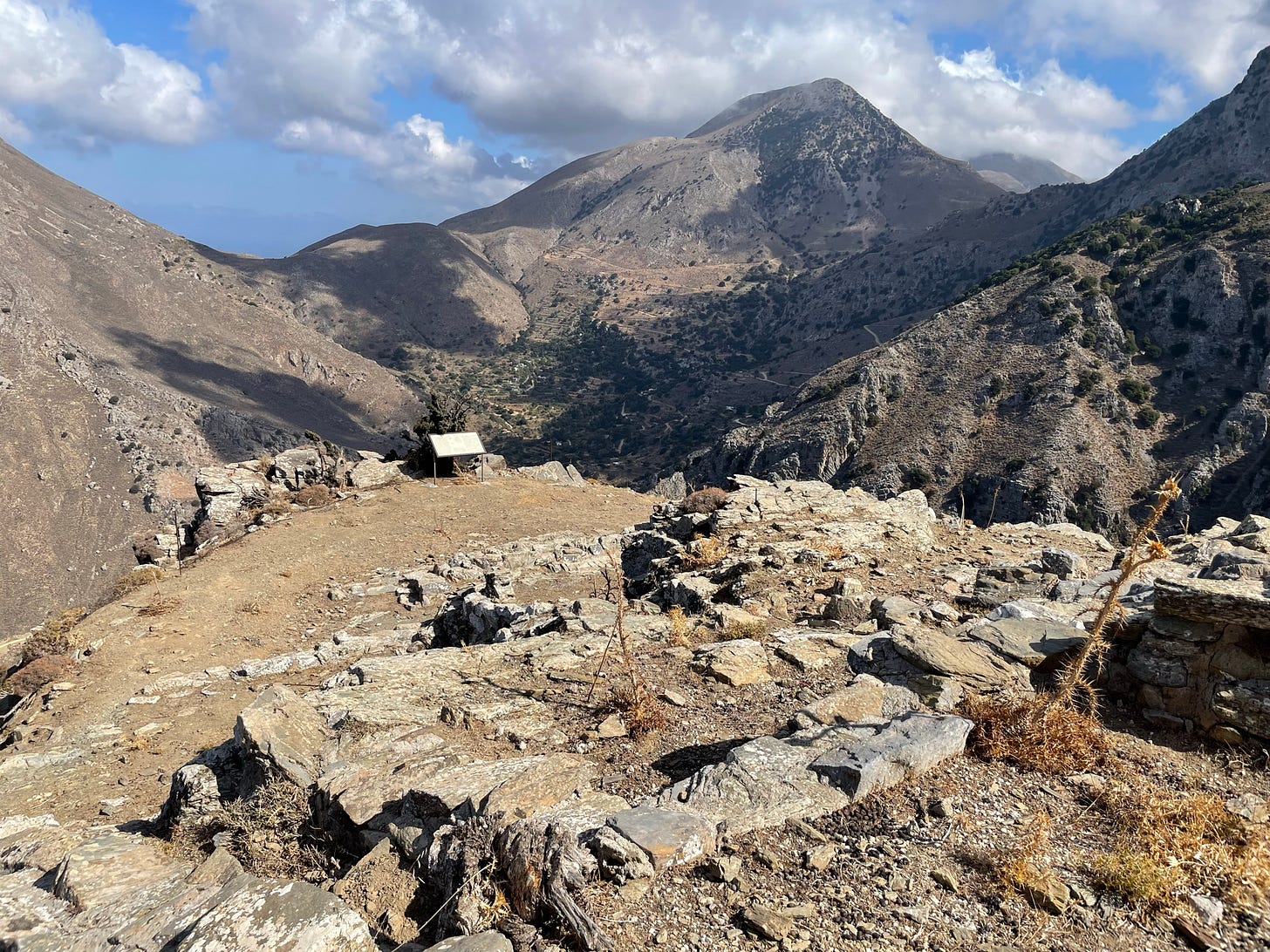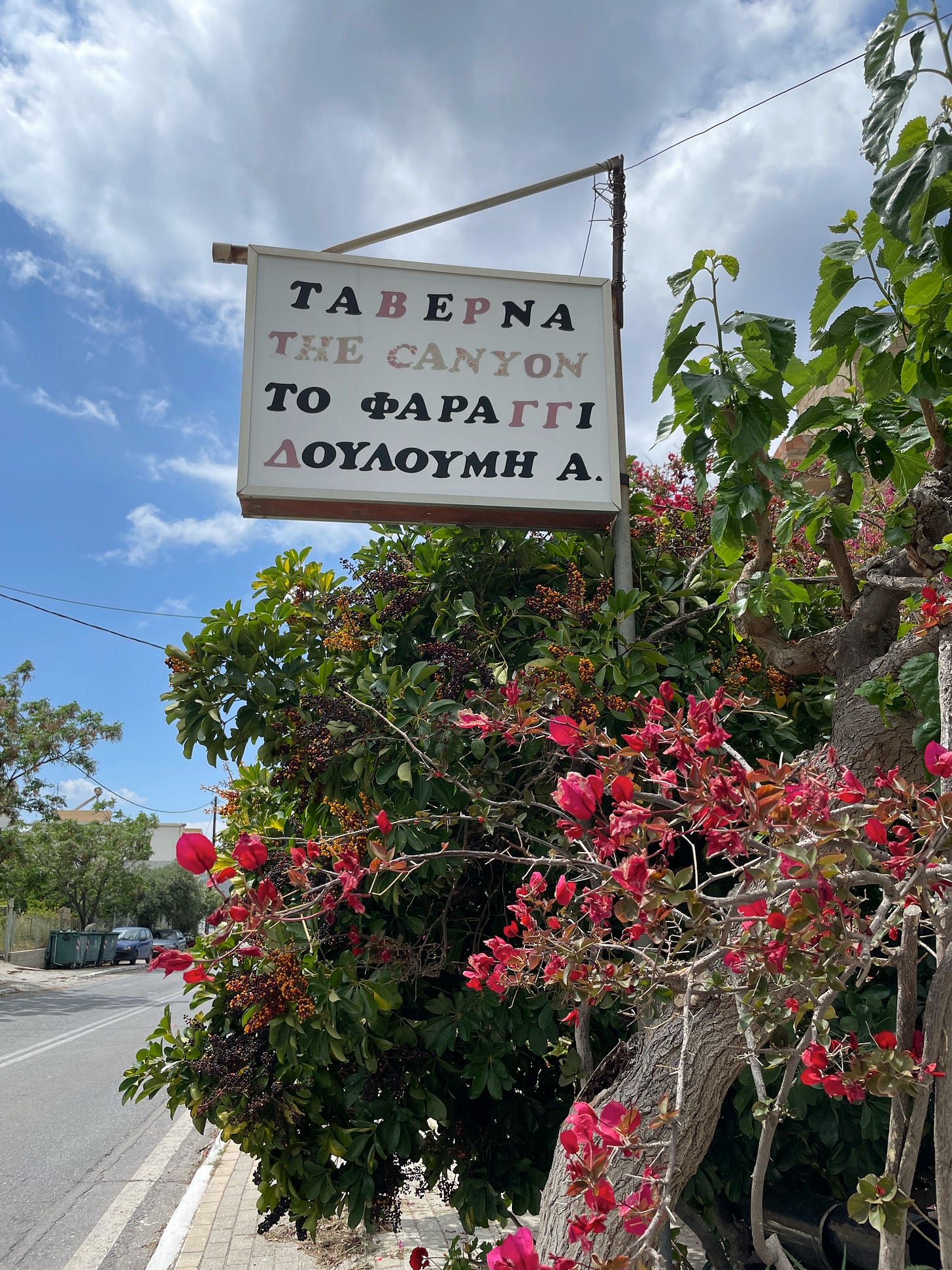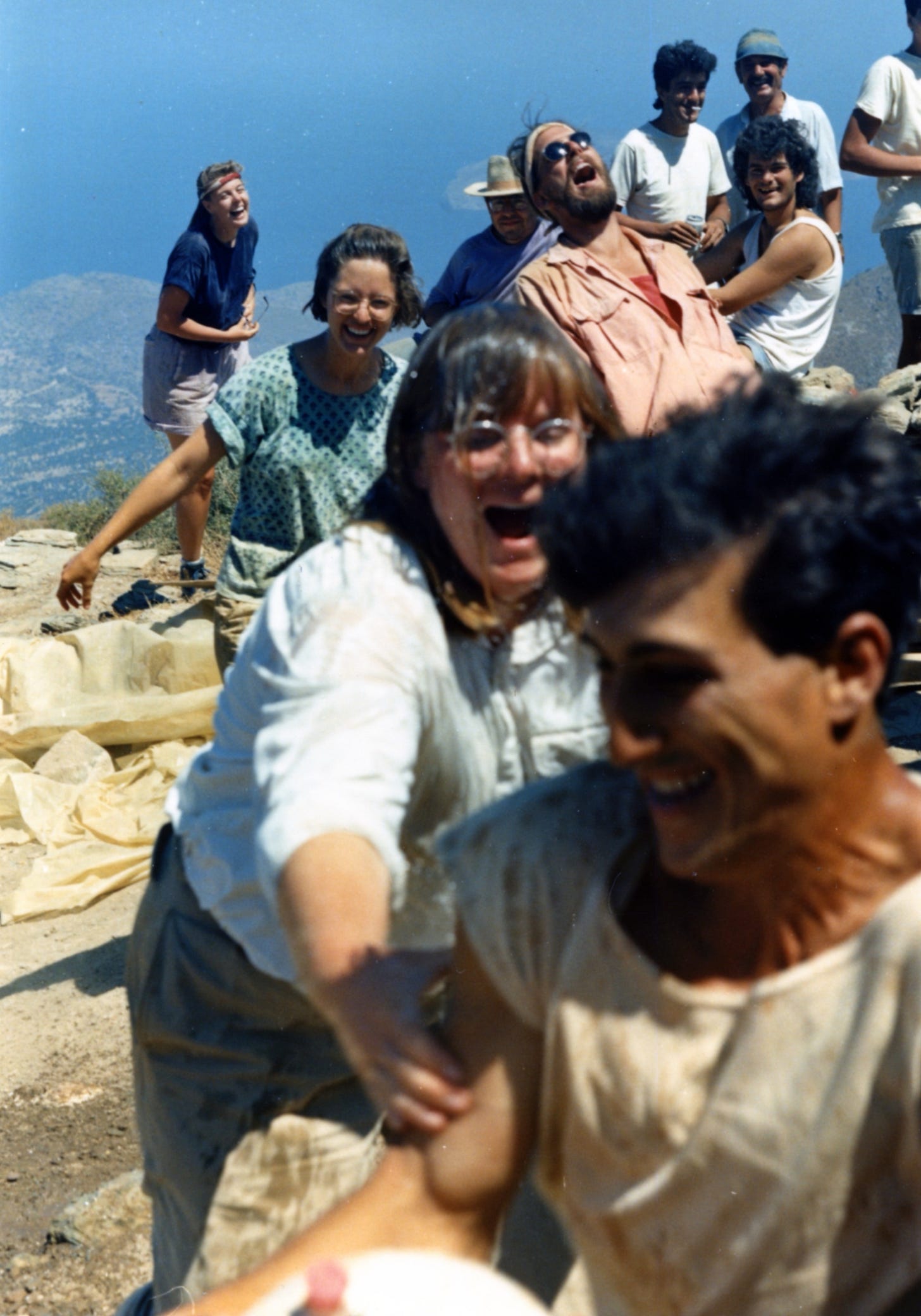Kavousi 1990
— Amy Hackney Blackwell, Christopher Blackwell
Part 2 of 4
This is a long story, so we’ve divided it across several parts:
1. Kavousi: A Love Story (Introduction)
2. Kavousi 1990 ← You are here
3. Kavousi 2023
4. Kavousi 2024
Raiders of the Lost Ark has been one of my favorite movies ever since Stephen Berry’s mom, Betty Berry, took him, me, and my brother to see it in the theatre. Archaeology! How exciting!
When I got to Duke, I thought I would finally have the chance to study archaeology. It would be just like Indiana Jones’s class at Stanford, or whatever university he’s meant to be teaching at, though I never could make out exactly what he was talking about in the lecture scene. Anyway, Duke! It’s a university! Surely there would be archaeology!
Duke chapel, same as it ever was.
Well, yes and no. What I didn’t know is that not every university has all the things, and most class offerings are highly dependent on what the given professors feel like teaching at any given moment. And it’s not the easiest thing in the world to even figure out what department would teach archaeology. Egyptian stuff? Not at Duke. (Maybe in Religion?) Dinosaur bones? Likewise. (Geology?) Anthropology didn’t have much in the Indiana Jones line, though they did have some solid physical anthropology offerings on hominids, and I did enjoy my classes at the lemur center.
But I have my modest store of student-craft, so I did what one does in these situations: I asked my classics-major boyfriend what he thought. (This was shortly before I met Chris….) He suggested that I take John Younger’s Aegean Bronze Age class. So I did.
This class was great! It was all about Crete, plus Mycenae. And Thira, before Santorini was a thing. Maybe some other Aegean islands, I can’t remember.
We studied all the major sites in Crete–Knossos, Kato Zakros, Phaestos. For my project, I searched the Linear B records for references to bull leaping. (My findings: the Linear B records say nothing whatsoever about bull leaping because they are just inventories of pots and such, though bovids are mentioned in a few lists.) The next semester, Younger set me up with an independent study reading through Sir Arthur Evans’ diaries from the excavations at Knossos. I loved me some Crete!
So it was a no-brainer for me to ask him if he could get me onto a dig the summer after I finished study abroad in Paris. No problem, he said, and sent me to Kavousi.
Junior year abroad in Paris was fun!
Eastern Crete
Getting to eastern Crete in June, 1990, wasn’t quick or easy. Here’s what I did:
I took a charter flight from Orly airport to Athens. Charter flights aren’t scheduled until a day or two before departure. This one ended up leaving in the afternoon, putting me in Athens at the same moment that the overnight ferry departed to Heraklion from Piraeus. I was supposed to turn up in Kavousi the next day, so this was a problem.
I walked from the international terminal to the domestic terminal and bought the cheapest ticket to Heraklion–$50, leaving at 5 a.m. Athens airport looked like a bus station in those days. I checked in my bags for the flight.
I took a city bus into town and got off at Syntagma. I spent the evening wandering around the National Gardens and the lower slopes of the Acropolis–only the top was enclosed in those days.
After it got dark, I took the bus back to the airport and spent the rest of the night sitting there. I befriended a young German woman who was on the same flight; she was going to meet her Cretan boyfriend.
We boarded before dawn and landed in Heraklion as the sun came up. Heraklion airport looked even more like a bus station than Athens airport.
I took a city bus to the eastern Crete bus terminal.
I boarded another bus for the two-hour drive to Pacheia Ammos, where the dig personnel were assembling and where most of them were staying. I had no idea the drive would take two hours, though, so I kept setting my alarm in ten-minute increments so I wouldn’t sleep through my stop.
In Pacheia Ammos, I learned that I’d be staying in Kavousi itself. A few us us drove the 15 minutes further east to our summer home, and I moved into my room around noon.
That was a long trip.
The road into Kavousi
The town
So, Kavousi. Today, Kavousi is a very small town located on the Lasithi plateau about half an hour east of Agios Nikolaus. The permanent population is about 600. That hasn’t changed much since 1990.
But Kavousi has been inhabited for millenia. Kavousi itself is situated in a lovely area, with access to both mountains and the sea. The main highway still runs through it, evidence that it’s at an ideal crossroads location. The name “Kavousi” is a Cretan dialect word for “water source,” suggesting that this might have been a reason to settle here.
Someone planted an olive tree there a very long time ago. Minoans?
This olive tree is said to be 3,400 years old!
In 1990, the town was just beginning to modernize. There was electricity, but no air conditioning. I shared a room that had two twin beds with another girl. We had a bathroom, but you couldn’t put toilet paper in the toilet. (It took my roommate a few days to believe this.) There was no storage, so we kept our things under our beds.
My roommate and I had the center room facing the street.
The one-room “grocery store” sold an odd assortment of things–eggs, koulouri, eastern European nutella knockoffs.
A few old people still lived in literal hovels on this street.
The Kastro
The site on the Kastro
The Kastro site, perched on a mountain peak, was founded around 1,200 BCE. It’s a bit younger than the lower Vronda site, where most of the dig was concentrated. The name “Kastro” means “c
astle,” though there’s nothing about the Kastro that would remind anyone of an actual castle. It’s just a few “houses” stuck on top of a mountain, and they were not nice houses.
The Kastro itself would have been a rough place to live. The views are amazing, to be sure, but living up there would have been … hard. There’s no obvious spring nearby. The east side is at the top of a gorge. I can’t imagine having babies up there. They would just toddle right off the edge.
But the Kastro was inhabited from 1,200 until the late 7th century BCE. That’s a good five hundred years. The people who lived up there must have had a good reason to put themselves to such inconvenience and danger. Pirates, say historians. Better to live on a waterless mountaintop than have your children snatched from their beds at night….
Getting to work
The Kastro is up there.
Dig days started early. My alarm went off at 5:25. I’d put in my contacts, don my work clothes, and eat a tiny breakfast of two McVities Digestive Biscuits spread with either Nutella or a low-rent Greek knockoff; it tasted the same, but always had half an inch of oil sitting on top of the chocolate spread.
McVities Digestive Biscuits, still popular today!
Those of us staying in Kavousi itself had it easy–we strolled down to the Pharangi taverna and boarded the pickup trucks at 5:50. The rest of the team had to get up and out early enough to catch the bus to Kavousi first. (Or maybe the trucks picked them up? I don’t remember. Maybe the bus didn’t run that early.)
It was dark. That summer I discovered the procession of the stars across the heavens. I’d never before noticed that the moon rises noticeably later every day, or that the stars are in a slightly different place every morning–the moon is easy to see, but the movement of the stars is only apparent if you watch the sky from the same place for several weeks.
We sat on two-by-fours in the backs of pickup trucks. That’s always been one of my favorite modes of travel in hot, dry places like summer camp in West Texas. In un-air-conditioned eastern Crete, it was the only time we felt a breeze.
We drove up the dirt road next at the western end of Kavousi, winding among the olive groves and bouncing on the rocks. It took about 20 minutes to reach the lower site, Vronda, where most of the crew disembarked.
This area is riddled with ancient sites.
The Kavousi team kept on going to the little dirt cutout under a sheer cliff face where it was possible to turn around and park two trucks. There, we got out and started climbing.
To reach the Kastro, we hiked up an old “cobbled Turkish road” called a kalderimi.
A cobbled road–what does that mean? It means a trail, but one that’s been enhanced with rocks and that at least used to be maintained. It was narrow, rocky, and twisty, and some bits were steep.
The kalderimi, an old cobbled path.
Two older men met us at the trailhead, having walked up from Kavousi with donkeys. These donkeys carried some water up, but they were mainly there to transport our potsherds back down. The men murmured endearments to their donkeys all the way up and down.
Up and up we went, everyone generally walking alone with their pre-dawn thoughts.
At its top, the path to the kastro crosses a little pass to get to the east side of the mountain.
This was our destination: the Kastro.
There was a gorge off to one side.
I recall it taking us about 30 minutes to climb from the parking area to the Kastro; more recent experience suggests that it must have been closer to 45 minutes. And not everyone was young!
That was a wonderful way to start every day. The Mediterranean was always visible off to the north. Sunrise gradually got later and later over the course of the summer, until we were doing almost the entire walk in the pre-dawn dusk, and the sun appeared over the tops of the peaks to the east as we rounded the bend to the gorge that lay to the east of the Kastro.
The hills rang with the distant clangs of goat bells.
A day on a dig
The view from the top
Having arrived at our mountaintop worksite, everyone took a moment to collect themselves. The veterans all had frappé shakers so they could make themselves instant Nescafe. Bill Coulson always started the day with a shot of raki, which he would generously share with me. It’s not a habit I’ve maintained, but it did wake me up.
Each grad student or professor was in charge of their own portion of the dig, which amounted to each person excavating their own house. Everyone had a trench assistant. I was one of those.
At the start of the dig, I hadn’t been assigned a trench, so Donald Haggis took me on as an extra assistant; he was already working with a young Greek woman. He was excavating a house on the west side of the main peak. He was also doing a bigger project, a field survey of this part of eastern Crete.
Donald Haggis and me in his trench.
The work was kind of meditative. (Not to say boring….) We slowly and painstakingly chipped the dirt off the rocks that had formed the base of the walls of houses. We made great use of whisk brooms, sweeping the dust off the dirt. The trick was to find a “floor,” which was difficult, given that any floor would be made of the same dirt we’d just dug off it.
As we dug, we’d turn up bits of long-broken pottery. These all went into collecting buckets.
Donald taught me how to make measured drawings using a string and a tape measure. I enjoyed making those. He also showed me how to use the surveying telescope for taking elevations.
The west wing of the Kastro settlement.
Jennifer Tobin arrived a couple of weeks into the season, and I moved over to her trench on the northeast corner of the site.
This trench was a potsherd mecca!
The point of all this activity was to get a good overview of the settlement and its history. (All results described in the linked publications. I myself am no expert on this field!)
At 10:30, the dig leaders would call “Kolazo!” That was the signal for our lunch (breakfast?) break. We’d sit down in the odd patches of shade with our Laughing Cow cheese, crackers, boiled eggs, and whatever other foodstuffs we’d managed to find that would survive the walk up the hill. Canned tuna with peas mixed in was a popular discovery.
As the summer wore on, I befriended several of the local workers, and my lunches got immeasurably better. A 12-year-old boy who’d landed a job (at union rates!) always had a great pile of containers of food furnished by his mother–bread, mizithra, kalamari. He would say to me: “Amy! Eat! Kalamari!” And I did.
After lunch, we’d work for another couple of hours. Around 1:30, the workers would load up the donkeys with the day’s finds, and we’d head back down the kalderimi path to the trucks. This walk always went faster than the walk uphill. We’d pile back into the trucks, stop at Vronda to pick up the rest of the dig staff, and drive down to the Apothiki.
It never once rained. Not once, all summer. My nose was always full of dust.
No plants up there that summer!
Apothiki afternoons
The apothiki.
The whitewashed apothiki at the top of town was the dig’s workshop. This was where we sorted our pottery, redid drawings using the light table, and … I don’t know what else. Mainly we sorted pottery.
Kavousi’s residents apparently loved dig time because they made bank. While most of the guys were up on the dig doing heavy manual labor, the town’s women got jobs washing pottery. They’d spend part of the day sitting at the apothiki, scrubbing dirt off potsherds with toothbrushes. They were instructed to work gently, so as not to scrub off paint or clay as well, but this did not always happen. It was even rumored that when the bristles wore completely off the brushes, they’d simply turn them over and scrub with the back sides.
Every trench had its own table made of trestles and plywood set out under the trees. When the ladies were done washing the potsherds, they’d spread them on the respective tables to dry in the sun. The previous day’s pottery was always still slightly damp when we arrived.
First thing, everyone would put in a drink order, and someone would bring up heaps of cold cans from the Pharangi taverna. I started the summer drinking Coke, but soon switched to Limonata and club soda. We were so thirsty, and the club soda had a bit of salt in it that seemed to help with my nighttime leg cramps.
We could never drink enough.
The apothiki also had the only toilet we encountered during the workday. (Most days on the Kastro, I just never went. It was so dry. If anyone did need to go, they had to pick their way around the high side of the gorge and find a convenient rock or bush.) It had a bucket flush system–you filled a bucket from a hose and dumped it into the toilet to flush.
We spent the afternoon sorting our broken bits of pottery into categories–edges, handles, bases, spouts, body pieces. Anything with paint got special attention. We’d try to fit pieces together, but that was mostly a fool’s errand after 3000 years. It was easiest with potsherd’s we’d accidently broken ourselves.
I’m told that the junky pottery got dumped into a well at the end of the season.
Evening: the Pharangi taverna
The sign at the Pharangi, named for the gorge across the street. It was owned by the Douloumi family.
At 5, we were done. We walked down the steep, grooved pavement though the town and crossed the street to our rooms. We showered. I’d wash my dig clothes at the same time. Showers were supposed to be short to conserve water, and some of us observed that we always finished our showers with a lingering coat of dirt on our skins that came off on the towels. We hung our clothes to dry on the clothesline on the balcony, and then walked down to the Pharangi.
Imagine this patio full of tables.
I never knew why we always went there. There was a perfectly good taverna under our rooms, and we did eat there once or twice, but the Pharangi was the social nexus of the dig.
Manolis Douloumi was in his early 20s at the time, and he was the master of the establishment during his summer breaks from the University of Thessaloniki. He was always so friendly and happy to see us.
Manolis only came up the mountain once that summer, for the end-of-dig party. Usually, he had to work in the taverna. That’s him on the right, in the blue plaid shirt.
The food there was simple, but it tasted so good. The chicken tasted like the herbs everywhere on the hillsides. Manolis says the french fries were so delicious because he fried them all in his family’s olive oil. My favorite meal was kalamari and horiatiki.
We helped ourselves to soft drinks from the fridge. Wine came in little pitchers filled from a barrel of the Douloumi family’s wine.
And oh, it was cheap! The whole summer cost maybe a thousand dollars, including room and occasional bus rides.
The Pharangi was where we received and made phone calls. I gave my parents the number and told them the times I was likely to be around, and they would call me once a week or so. It was MUCH easier to have them call me than to call out, which involved multiple numbers and a calling card, and mostly just didn’t work anyway.
Entertainment
There was not much to do in Kavousi. The TV at the Pharangi played Greek television, mostly the World Cup or politics. No one had computers or cell phones in those days!
Kids today might find this hard to believe, but we managed to entertain ourselves. We read a lot. Favorite novels were passed around based on an informal waiting list. The copy of a Clive Cussler novel involving a sexy lady archaeologist was especially popular. (I just did a little searching, and I have identified this book as Treasure, published in 1988. It begins with the sexy lady archaeologist working in Greenland, where her parka conceals the size of her assets. She and Dirk Pitt then proceed to travel effectively everywhere in search of the lost Library of Alexandria.)
I read my first Robertson Davies novel, The Rebel Angels, which rocked my world and had a lot to do with the path that I followed immediately thereafter. I wanted to be the character Maria–so sophisticated and cosmopolitan and exotic and multilingual, and all her professors were in love with her! That book performed the minor miracle of making humanities grad school sound sexy. I read the notorious pink ribbon scene on the Sunday that a worldly grad student took me to the famous (notorious?) Vai Beach, land of nude Germans.
Some nights we played poker for drachmas. That was fun. Someone must have had a tape deck; Eric Clapton’s Timepieces and Van Morrison’s Moondance were sounds of the summer and the cds I bought the instant I got back home.
Every Tuesday and Friday afternoon, we were excused from apothiki duty. This gave us time to catch the bus into Agio Nikolaus or Ierapetra to visit a proper grocery store or ATM and grab a restaurant meal. Ag Nik had a Chinese restaurant that was especially popular.
Some Saturday mornings we worked at the apothiki. Those weekends, it was impossible to go anywhere substantial; it took two full hours to get to Heraklion on the bus, and we had to be back in Kavousi by Sunday evening. But we could still spend Sunday at the beach in Ierapetra or Agios Nikolaus.
Ierapetra was especially beautiful, with its view south over the Libyan Sea and its wooden platforms out in the water, though you had to avoid stepping on the sea urchins. It was a lovely place to while away an afternoon drinking frappés under a taverna shade.
Ierapetra is on the south coast, overlooking the Libyan Sea.
My first time in Ierapetra, I bought a pair of leather flip flops that were some of the best shoes I’ve ever had. I wore them all summer and kept them in my closet in Baton Rouge as pool shoes for years after.
Every other Saturday we had off. If we left Friday afternoon, we could actually go places. One weekend, I went off with the assistant paleobotanist and two other trench assistants for a trip all the way to Chania, at the western end of Crete. (The actual paleobotanist never showed up that summer, so the assistant was in charge of water seiving all the dirt specimens for ancient seeds or whatever.) The assistant paleobotanist gave me his walkman so I could listen to this great new band called They Might Be Giants as the bus drove west into the mountains near Ag Nik. We had to stay in Heraklion on Friday night because the bus got there too late for us to continue on. I ran into my Duke prof John Younger, who was drinking ouzo in the town square. Small world.
Chania looked then exactly like it does now, except with about one one-thousandth the number of tourists. I bought a couple of traditional Cretan knives there.
I tried going to the beach on the north coast a few times, but it was invariably disappointing. The beach at Sitia was about 2 meters wide, which seemed pointless, and the water in Agios Nikolaus was full of potato chip bags.
Sitia does have a pretty harbor, though.
One weekend, I went to Heraklion by myself to visit Knossos. I’m glad I did, because it was possible to actually see the place in those days, without today’s hordes of tourists. I doubt I’ll ever go there now.
End of summer
Archaeologists gone wild!
I left Kavousi in early August and made my slow and deliberate way back to Baton Rouge. The slowness was the result of silly decisions. Back in Paris, I’d bought a round-trip ticket between Paris and Athens from a charter company. These tickets were for specific dates, but you couldn’t find out what time they left until three days ahead of time. I was returning to Paris because I had a round-trip, open-ended student ticket between the US and Paris–one of those tickets that you couldn’t schedule more than 72-hours in advance, based on space available.
It was years later that it occurred to me that we could’ve saved a lot of trouble and money if I’d just bought a one-way ticket to Greece and then just flown straight home from there.
As things turned out, Duke called my parents and said I’d been made an RA. I had to turn up for training on a specific date in August. This meant scheduling a flight like a responsible adult with a job. So I had my dad buy me a ticket home from Paris the day after I was supposed to return from Greece.
To learn what time my flight to Paris would depart, I had to call the French charter company. This proved impossible to do with the Pharangi’s telephone. I basically had to go to Athens to make a phone call.
This time I took the overnight ferry, deck class as we students did. Never again! No matter how hot the summer, spending a night in the wind on the deck of a sailing ship is freezing. Also, a bench is not comfortable to sleep on.
In Athens, I spent three nights in a nice hotel near Kolonaki Square and the American School. That remains one of my favorite parts of Athens. I visited the Acropolis, the archaeology museum, and the Kolonaki Museum, where I bought a great pair of earrings and a book of embroidery patterns. I took two baths a day.
As a perk of the dig job, we got museum passes that let us visit museums and sites for free.
I made it back to Paris and thence Baton Rouge, of course. Three days later, I drove up to Durham. The next week, I attended a photo lecture by John Younger, who was sharing the story of his own summer in Crete.
There, I met a new classics grad student named Chris Blackwell. He invited me to see Fantasia with him. He wore an Atlanta Braves baseball cap held together with duct tape, he drove a pickup truck, and he’d read Robertson Davies, too.
This is a long story, so we’ve divided it across several parts:
1. Kavousi: A Love Story (Introduction)
2. Kavousi 1990 ← You are here
3. Kavousi 2023
4. Kavousi 2024

